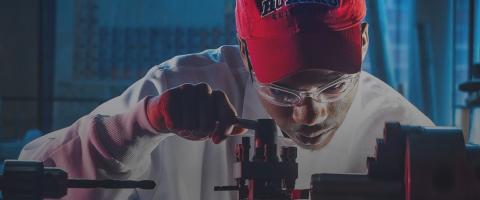Howard University Health Sciences Core Laboratories and Shared Resources
Georgetown-Howard Universities Center for Clinical and Translational Sciences
Biomedical Imaging Core
Director: Paul C. Wang, Ph.D.
This core facility supports multidisciplinary biomedical research using modern imaging technology to train a new generation of young scientists. It is equipped with three (3) laboratories:
Molecular Imaging Laboratory: Lab Director, Paul C. Wang, PhD. Comprised of three subunits, the laboratory provides distinct expertise in molecular biology, in-vivo imaging and probe design. It is equipped with two state-of-the-art NMR machines capable of in-vivo high resolution spectroscopy studies; an advanced Xenogen IVIS Spectrum imaging system; and necessary equipment for cell culture, chemical analysis and construction of molecular probes.
Electron Microscopy Suite: Director, John V. Massari, PhD. This laboratory is one of a handful in the country with technical expertise to perform dual-labeling immunocytochemical ultrastructural studies in neural tissues. It contains a JEOL-1210 transmission electron microscope (with a digital camera system and software for image analysis), a Reichert Ultramicrotome, Vibratomes and diamond knives.
Confocal Microscopy Laboratory: Director, Eva Polston, PhD. This laboratory is equipped with an Olympus Fluoview 300 confocal microscope fitted with three (3) monochromatic lasers for visualization of fluorescent molecules or endogenous fluorescent proteins. The confocal microscope provides the unique ability to image photons emitted from individual focal planes allowing for their localization within a three-dimensional sample. The imaging station also provides Sigmastat software for statistical analysis of imaging data, as well as the Adobe Creative Suites package used to process raw confocal files for creation of publication quality images and figures.
Center for Computational Biology and Bioinformatics
Director: William Southerland, PhD. The center provides the necessary human, software and hardware resources to perform computational biomedical research on gene and protein sequence analysis, the design and development of new and improved therapeutic agents, biomolecules and biomaterials, and the development of a better understanding of cellular processes. The laboratory provides support for research in the following areas: 1) bioinformatics and statistical genetics, 2) macromolecular analysis and simulation, 3) virtual ligand screening and database development, 4) computational chemistry, and 5) computational proteomics and methods development.
Proteomics Core Facility
Director: Sergei Nehkai, PhD. The Proteomics Core provides mass spectrometry support and is equipped with analytical instrumentation and technical expertise for proteomic analysis for basic biomedical and clinical research projects. The Proteomics Core Facility provides training for students and faculty in biomolecular analysis through methodology-centered seminars, workshops, mini-courses, and internships; it fosters multidisciplinary research collaborations using modern Proteomics technology.
Sickle Cell Center Research Scientist Laboratory
Director: Victor Gordeuk, MD. This core laboratory is an integral part of the NHLBI Research Scientist Program and the Center for Sickle Cell Disease. It contains bench space to accommodate up to eight (8) researchers and has capabilities for advance biochemical, molecular biological and proteomic research. The laboratory contains: a sterility cabinet, a walk-in cold room, a chemical hood and other equipment (including low and high pressure chromatography systems, various centrifuges, plate readers, spectrophotometers, scintillation counter, phosphoimager, speedVac and gel dryer, PCR machines including quantitative PCR, digital cameras and incubators with CO2). It also accommodates a MultiPlex (Bio-Rad) instrument.
Flow Cytometry Core
Core Leader: Xinbin Gu, M.D., Ph.D. This facility is equipped with a two laser, six (6) parameter, four (4) color Becton Facscalibur Dickinson FCB4S instrument, available to both clinical and basic science researchers. The flow cytometer is equipped with CELLQUESTpro and Modifit Cellquestpro, which are data acquisition and analysis pro-grams that operate in the Macintosh environment. Modfit is designed to analyze DNA histograms and has advanced capabilities for aiding the user in handling background, aggregates and debris. The core provides user access to flow cytometry equipment, analysis of user-prepared samples, sorting (separation) of cell subpopulations, graphical and statistical analysis of data, archiving of flow cytometry data files, presentation graphics, training in instrument operation and consultation in assay design.
Molecular Genetics Core
Core Leader: Georgia M. Dunston, Ph.D. The molecular genetics laboratory contains all the standard equipment necessary for large-scale, high throughput molecular analysis of DNA variation. These items include centrifuges, water baths, gel electrophoresis apparatus, pipettes, glassware, balances, and two ABI 373 automated sequencers. Also available are industrial freezers, refrigerators, a dark room, and an electron microscope. The laboratory has two Transgenomics DNA Wave machines for SNP detection using dHPLC. The genotyping room contains three ABI 377 automated sequencers,10 Perkin Elmer 9700 thermocyclers and a PSQ 96 Pyrosequencing platform for SNP genotyping. An immunogenetics core research laboratory provides additional space for molecular genetics work. And, a separate tissue culture facility is available for extraction of DNA from blood samples and EBV cell transformation.
Animal Core Facility
Core Leader: Doris Hughes-Moore, D.V.M. The Howard University Veterinary Services, an accredited independent laboratory and animal facility, provides professional animal care and technical services for biomedical researchers. Veterinary services includes: receiving, quarantine, isolation, aseptic surgery, necropsy, radiology, diet kitchen, food storage, bedding storage, cage wash, equipment storage, a clinical laboratory, procedure rooms, locker/change rooms, and administrative offices. The 13,700 square foot facility has the capacity to house rodents, small mammals, small hoofed stock and amphibians. It has biometric access to provide 24-7 safe access and a secure environment; a full-time veterinarian and technical staff provide around-the-clock staff coverage.
Clinical Research Unit (CRU)
Director: Thomas Mellman, MD. The Clinical Research Unit is funded by a prestigious NIH Clinical Translational Science Award, in partnership with Georgetown University. Located in Howard University Hospital, the 5200 square foot facility includes three rooms with hospital beds and 24-hour nursing coverage. This unit serves as the site of most clinical or human subject research activities at Howard University. CRU nurses provide phlebotomy services, biological sample collection, survey administration, overnight sleep studies and metabolic assessments, as needed.
Biobehavioral Core Laboratory
Core Leader: Teletia Taylor, Ph.D. This laboratory provides equipment for clinical exercise physiology and psycho-physiological research. It has a Cosmed Quark b2 metabolic cart and a Cosmed electrocardiogram (ECG) equipment, which is programmed into a Burdick Treadmill to perform graded exercise tests that assess risk for cardiovascular disease and functional work capacity training. An Ergoline 500 medical ergometer is used for exercise testing when a cycle ergometer is needed. In addition, the laboratory has three other treadmills used for exercise intervention training programs and a surveillance camera (Security Labs) used to monitor study participation. To collect impedance cardiograph data, the HIC-2002 Impedance Cardio-graph is used along with the COP –Win 5.10 USB version cardiac output program for windows. This equipment is designed to measure a variety of cardiovascular measures (heart rate, stroke volume, cardiac output, pre-ejection period, left ventricular ejection time, total ejection period, and heather index). The Dinamap Vital Signs Monitor (Model 1846 SX) is used to assess systolic and diastolic blood pres-sure. The lab provides psychological testing using the Automatic Mirror Tracer (Model 5403), the Pea-body Picture Vocabulary Test (3rd Edition Form IIIA and Form IIIB) and the Wisconsin Card Sorting Task for Windows.
Center for Drug Research & Development
Director: Emmanuel Akala, PhD. This new facility, located in the College of Pharmacy, allows for small-scale production of pharmaceutical products and provides contractual services to biotech and pharmaceutical industries for Phase I, II studies.
Common Equipment Core
Core Leader: Marc Britton. The common equipment core includes equipment shared by members of the Cancer Center including: ultracentrifuges, scintillation counters, autoclaves and freezers. A Realtime PCR machine is available to enable investigators to quantitate levels of mRNA expression in extremely small cell samples. The Imaging Facility serves to facilitate the collection and analysis of autoradiographic data. The phospho- imager has chemiluminescence and fluorescence capabilities.
Nutrition Assessment Core
Core Leader: Mireille Bright Gbebry, MPH, RD, LD. This core provides dietary assessment necessary to plan and conduct research that demands nutritional support. Methodologies to assess nutrition risk and comprehensive evaluation of nutritional status include anthropometrics, bioelectrical impedance analysis, food intake (administration, review and analysis of dietary intake via quantitative food frequency questionnaires, food diaries, diet recalls and diet history) and nutrition analysis via computerized analysis of dietary intake using nutrient data analysis software. Additional services provided are diet education, protocol development and training.
Tissue Repository Core (Cancer Center)
Core Leader: Wayne Frederick, M.D. The repository is responsible for tissue collection, conducting prognostic indicators and diagnostics, storage and data management. The collection of specimens from patients undergoing surgical procedures at Howard University Hospital is being conducted through collaborations with the Departments of Surgery and Pathology. A database with the de-identified specimens has also been created. The collected specimens are from a variety of tissue sites including breast, colon, rectum, stomach, ovary and liver. Databases linking the samples and the exact patient demographics are maintained in a password-protected file, housed in the HU Cancer Center and the Department of Pathology.
Biostatistics Core
Core Leader: Kepher Makambi, Ph.D. The Biostatistics Core provides statistical and data management support services regarding study design, randomization, power analysis, data processing, quality control, database development and management and statistical analysis for clinical and population based studies.
Clinical Protocol & Data Management Core
Core Leader: Evelyn Smith-Owusu, RN. This center facilitates the implementation, conduct and monitoring of regulatory issues associated with clinical trials in the Cancer Center. It supports cancer control, chemoprevention and treatment trials (primarily Phase III trials) for the Minority-based, Community, Clinical Oncology Program. The key responsibilities of the Core are: study recruitment and enrollment, data management, compliance, patient adherence and follow up.


